Skin Cancer – Mast Cell Tumors (Mastocytoma)
SKIN CANCER – MAST CELL TUMORS
[ad name=”Tweet”]
Mast cell tumors can be found anywhere on or in the body of your pet, but are most commonly found in the skin of dogs. Breeds such as the Boxer Dog, Staffordshire Bull Terriers, Boston Terriers, Rhodesian Ridgebacks, Pugs and Bull Mastiffs appear to be predisposed to developing these cancerous growths. Cats can also develop them, but it is far less common.
What are Mast Cells?
Mast cells are found in the body, and are important in the normal functioning of the immune system. They are often seen in areas where there is an allergic reaction to something – for example, dogs with very itchy skins will have more mast cells in their skins than normal dogs. Mast cells contain granules of histamine and heparin that are released when the skin is inflamed, causing redness and itching of inflamed areas.
What are Mast Cell Tumors? (Mastocytomas)
Mast cell tumors are cancerous growths of mast cells – cancer is the unregulated division of any cell in the body. They can be found anywhere on or in the body, but are seen most often on the skin of dogs, most often having the appearance of an innocuous looking lump. They can look and feel like anything – from small hardening in the skin, or a fatty mass to an enormous red weeping lump. Some dogs develop single tumors and a small percentage develop multiple tumors.
Often people say they have been there for a while, and suddenly started enlarging and irritating the pet, which then chews or scratches a lot in the area of the lump. The skin around the lump can become puffy, red and itchy in some cases, due to the granules inside the mast cells being released. They can spread internally to local lymph nodes and from there most commonly to the spleen and liver.
How are these Cancers Diagnosed?
If your vet finds a lump on your pet’s skin, he or she should take what is known as a Fine Needle Aspirate of the lump prior to surgery, to see what it is. Basically a small needle is pushed into the mass – it doesn’t feel any different to a normal injection, so your vet can do this while your pet is in the consulting room, in most cases. Your vet will then pull back on the syringe to draw cells into the needle and then remove the syringe and needle, and spray the cells onto a glass slide. He/she will then stain this and examine it under the microscope for mast cells. Mast cells contain very dark blue granules, which makes them distinctive from other cells. It is far less risky for your pet to have this diagnostic procedure than to cut into or remove the lump without checking it first, which can lead to the cancer spreading into the body. Your vet should also check the glands or lymph nodes that drain the area with a needle as well for mast cells.
A good vet will also give you the option of blood tests to check for circulating mast cells, as well as blood tests organ function prior to surgery, chest X rays and/or ultrasound possibly with aspirates of the spleen or liver to check for internal masses at the same time as it is pointless putting your pet through extensive surgery if it has already spread internally.
How are these Cancers Treated?
Once a mast cell tumor is suspected, your vet will usually advise you to have it removed. If it is very large or very inflamed, he/she may first recommend shrinking the mass or controlling infection or inflammation with antibiotics, chemotherapy or radiation prior to surgery. When these tumors are removed, it is best to remove at least 3cm of skin or tissue around and below the tumor and not to cut into the tumor at all, as some tend to be quite malignant and a single cell left in place will allow the cancer to recur or spread into the body.
A lot of people collecting their pets get a shock when they see the size of the cut needed to remove what appeared to be a tiny lump. It is best to be prepared for a large cut when you collect your pet. If the cut is small, not enough tissue may have been removed, and your pet may need to be re operated on, which is a lot more tricky. Also, I commonly see that pets tend to lick and chew the stitches out a lot more with this type of cancer than with other types, as the wounds tends to itch a lot, due to the chemicals being released from the mast cells. Once the lump is removed, it and all the surrounding skin will be sent to a pathologist. The pathologist will check all the borders of skin, to make sure they are free of mast cells, as well a grade the mast cell tumor into grades 1,2,3, and 4. Tumors on the paw, muzzle and in the gut have a guarded long term prognosis.
Grade 1 Mast Cell Tumors
Grade 1 mast cell tumors that have been completely removed need no further treatment but careful monitoring of your pet for any more lumps that develop is necessary. Any lump on your pet should be checked by your vet. They are considered to be well differentiated, which means the cells still look like normal mast cells.
Grade 2 Mast Cell Tumors
Grade 2 mast cell tumours with clear borders can usually be left alone. If the pathologist finds mast cells on the borders, you will be given the option of either re-operating or using chemotherapy or radiation to kill the remaining mast cells or both. Unfortunately, there is varied opinion as to how effective chemotherapy actually is in controlling the spread of mast cells. They are considered to be moderately differentiated, which means the mast cells resemble normal mast cells.
Grade 3 and 4 Mast Cell Tumors
These are considered to be poorly differentiated, which mean the mast cells do not act or look like normal mast cells at all. If the borders aren’t clear, your pet will need to be operated on again to remove all the cells and most likely given chemotherapy or radiation as well, as soon as the surgical scar is healed. Your vet should also offer ultrasound, x rays and blood tests at this point to check for internal spread if it hasn’t been done already. Some vets will recommend amputation of a limb, if the mass is on a limb for aggressive grade 3 or 4 tumors to stop them spreading internally. This works well for small dogs, but bigger dogs may struggle especially if they also have concurrent hip or elbow dysplasia.
Staging the Tumors
The cancer should also be staged into stages 1-4 once these tests have been done, stage 1 being when it is only in the skin, stage 2 – when it has spread to the local lymph nodes or glands, stage 3 – when multiple tumors are found with spread to lymph nodes and stage 4- when it has spread internally. This will give your vet an idea of long term prognosis and how aggressively he/she recommends it should be treated.
Chemotherapy and Drug Treatment for Mast Cell Tumours
The most common drugs used in the treatment of mast cell tumors are the following:
Prednisolone
This is the most common cortisone based drug on the market. It helps to reduce inflammation of the surgical site. Side effects include weight gain, excessive appetite and thirst and suppression of the immune system if used in the long term. Prednisolone can also shrink the size of the tumor and is said to cause remission in a small percentage of low grade mast cell tumors.
Cimetidine
This is an antacid drug used as many mast cell tumors release chemicals that cause inflammation and ulceration of the stomach lining.
Vincristine
This is a form of chemotherapy that must be administered directly into a vein, best done with an intravenous catheter and a drip to make sure no drug goes outside the vein, as this can cause death of the skin and tissues around the needle puncture site and the skin will slough or fall off. This is best done with your pet admitted for short time, and not in the consulting room.
Prednisolone combined with Vinblastine and/or Cyclophosphamide
Vinblastine carries similar risks to vincristine and should be administered the same way. Cyclophosphamide comes in tablet form and can be given by owners at home. owners should be aware that chemotherapy drugs carry risks if they handle them, no pregnant woman should touch them, people should wear disposable rubber gloves when handling them and the tablets should never be cut up.
Chemotherapy basically kills all fast dividing cells in the body – this includes the cancer cells, but also tends to hit the lining of the intestines and the bone marrow. What this means is that your pet may experience nausea, diarrhoea and secondary serious infections. The most common secondary infection I see is serious pneumonia, requiring admission, drips and aggressive antibiotics to control.
New Drugs on the Market
Two new drugs currently being tested and licensed for the treatment of aggressive stage 3 and 4 mast cell tumours are called Palladia and Mastinib, both working by targeting specific molecules on the mast cells themselves, in order to inhibit growth.
REFERENCES
http://www.petcancercenter.org/Cancer_Types_mast_cell_dog.html
http://en.wikipedia.org/wiki/Mastocytoma
http://www.dogcancer.net.au/cancer-mast-cell.php
http://www.caninecancerawareness.org/html/CanineCancerMastCell.html
http://www.vetsurgerycentral.com/mct.htm

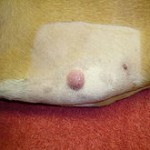
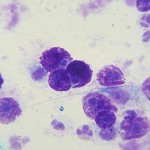
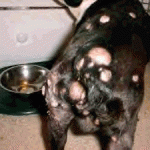
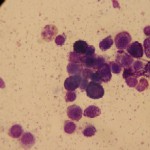
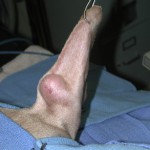
Leave a Reply
You must be logged in to post a comment.